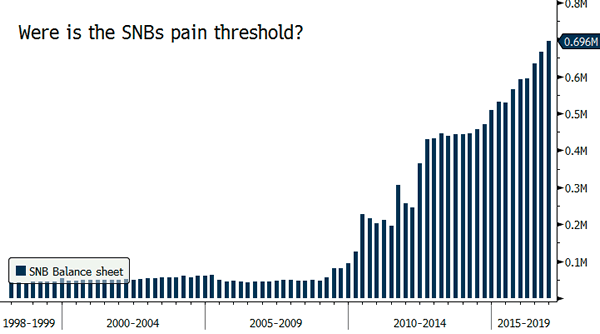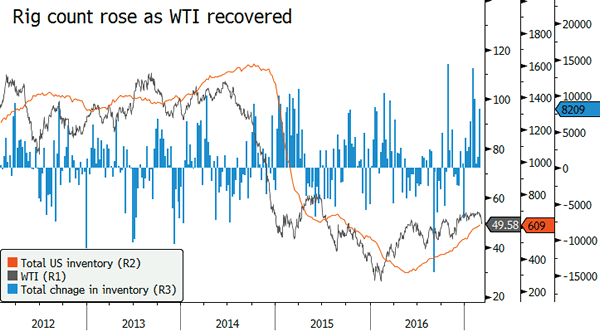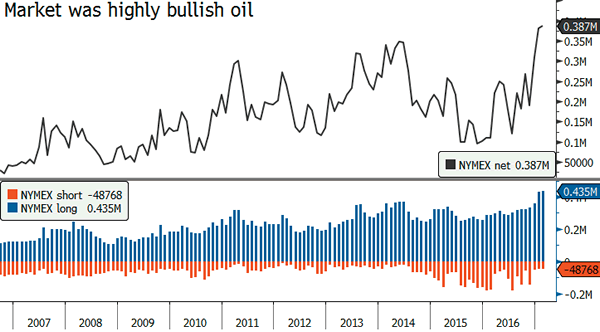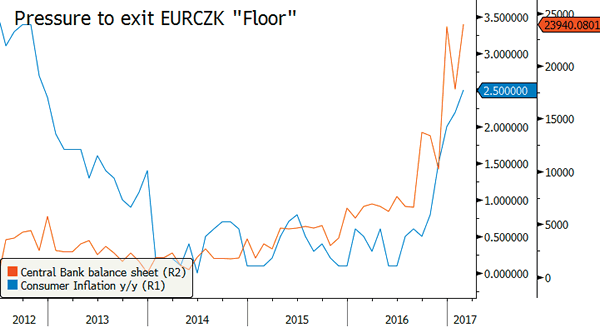SNB Could Be In A Corner
The ECB slightly hawkish policy meeting removed the selling pressure on the EURCHF in the near term. Yet with political risk in Europe increase the respite might not last. As everyone knows, the SNB has been intervening to protect the CHF from further "overvaluation". Today, the SNB released data indicating foreign exchange reserves surged 3.8% to 668.2bn CHF (Total balance sheet is over 115% of GDP). While the SNB does not generally comment on intervention, the size of the balance sheet expansion indicates that the SNB has been very active in FX markets (protecting 1.06 soft floor).
The problem is that the pace of purchases is unsustainable (printing unlimited CHF could lead to hyperinflation and credibility issues), yet demand for CHF is likely to increase (1. Rising political risk in Europe 2. EU-CH yield spread stable/narrowing 3. Swiss economic conditions are improving). The language of SNB around FX policy has softened (supported by a positive inflation outlook) adding to speculation of greater flexibility yet clearly demand for CHF has outstripped the SNB’s view of smoothing. EURCHF has become the "go to" trade to hedge European political risk, so selling pressure should increase as we head into the Dutch and French elections. Now I’m sure I don’t have to remind anyone that arguably the two biggest FX moves in the last few years have been created by the SNB (hence the concern), and their proactively addressing events/situation in Europe.
The problem is that, once again, the SNB is now "trapped" by their own policy. My concern is that the SNB’s "soft" FX policy has become "hard" in the market’s mind. When the SNB is forced to remove the verbiage/ physical intervention (not sure which comes first), we should see EURCHF move sharply lower. The longer the situation remains, the greater likelihood of an extreme event.

The ECB Is Showing Some Hawkishness
Last Thursday, the European Central Bank had its meeting and without no surprise, rates will remain unchanged. Plus, ECB President Mario Draghi did not mention anything regarding the monetary policy for next year after the end of the current QE program.
It is nonetheless clear that the ECB is rather positive on the outlook. Recent fundamental data has indicated some improvement. Industrial production growth is positive (+2% in December) and inflation has surged since the start of the year. Eurozone HCPI is now above the target of 2% according to Eurostat. It is the first time in four years that the central bank’s target has been reached even though core inflation is stalling around 0.9%.
We believe that ECB-Fed monetary policy divergence is becoming a reality while a US rate hike next week is now certain. The ECB for the time being remains largely all-in. We recall that from April the ECB will start buying €60bn bonds instead of €80bn until the end of the year. This should not last forever, because of bonds scarcity and the better data.
The statement is showing the ECB’s hawkishness
We consider that the ECB is now slightly hawkish as the statement did not mention that the central bank would use all available tools as it is normally the case.
We may now expect that the economic data, lower unemployment rate and greater inflation should push policymakers to envisage tightening in the medium-term. At the meeting, political uncertainties remained at the centre of attention, in particular the French and Dutch elections represents a risk for the Eurozone as nationalism is on the rise. Draghi replied that he does not see the Euro bloc breaking apart.
Out of the ECB meeting, the soft German’s data appeared concerning. Indeed the country is clearly the locomotive of the European economy. In particular its industry is the strongest of the Eurozone. Earlier this week, factory orders data have been released and have shown a sharp decline to -7.4% which is the worst month decline since 2009. The read was well below the consensus as decline of -2.5% was expected. The low interest rates era has helped the German economy but this does not seem sufficient as the demand is clearly weakening. Fundamental data must be compared with survey such as the IFO business climate or expectations which are showing some positiveness.
The euro barely moved last week and is still trading around $1.06. Optimism still seems to prevail on the market. The German DAX index is trading at all-time high and there is no reason for this move to stop in the short-term as economic expectations are strong for the time being. The ECB monetary policy is set to remain the same at least until yearend and we believe that the euro should stay weak and stocks markets overvalued.
Oil Caps Worst Week Since November 2016
The West Texas Intermediate is about to post its largest weekly decline since the first week of November when it dropped 9.50% to below $45 a barrel. This week, the WTI slid almost 7% as it dipped below $50 a barrel for the first time since the November OPEC "supply cut" deal. The move was initiated on Wednesday after the EIA reported that US stockpiles had surged by 8.2 million barrels in the previous week, more than four times what the market was expecting, pushing US inventories (excluding strategic reserve) to an all-time high of 528 million barrels.
The market has begun to consider the possibility that OPEC and certain non-OPEC members such as Russia, who initially agreed to curb production back in November, may now be backtracking on their promise. Indeed, the US shale industry was the primary beneficiary of this "supply cut" as shown by the massive rise in rig count (+38% or 168 new wells since November last year). In this fight, the US has been continuously increasing their market share on the back of those who agreed to cut production.
On the top of this, the market positioning on the NYMEX had reached extreme levels recently as the total net position hit 387k contracts. Even back in June 2014, the market wasn’t that bullish (348k net long). Therefore, we believe that there is room for further downside move in crude oil prices. Investors were betting that the recovery in prices would be proven sustainable as the main oil producers seemed to have found an agreement. We would not be surprised to see OPEC and Russia backpedalling on the "supply cut" deal as it is clearly to the advantage of the US right now. We expect further weakness of crude prices as traders unwind their long positions, with $45 a barrel as the next target.


EUR/CZK Exit Date Debate Increases
The SNB is not the only central bank whose FX policy is on a collision course with reality. The Czech Republic central bank (CNB) created a SNB style EURCZK minimum exchange rate in 2013. The CNB’s objective was to prevent the euro from depreciating, derailing the small export drive economy growth outlook and triggering broad deflationary pressure. With mostly verbal interventions, the CNB has been able to accomplish its goal and there is little doubt that members are committed to scraping the floor. There are two primary issues for FX traders the process for exit and timing.
The CNB has highlighted that a Swiss style abandonment will not occur. The central bank will continue to intervene to smooth out excessive euro weakness and the CZK Strength. While the CNB FX reserves have significantly increased since the start of the floor, reserves are not excessive like in Israel, Norway and Switzerland. Should demand for CZK become extreme the CNB will have a difficult managing it.
Accelerating inflation, quicker than expected reserve accumulation to defend the floor and the need to protect credibility have pulled in forecasts from eliminating the minimum exchange rate. Interestingly, the element of surprise no longer seems to a primary consideration for the central banks. Headline inflation has risen to 2.5% y/y from 2.2% in February, driven by volatile food and energy but pressure on core supports sustained price pressure
However, inflation is expected to return to the central bank’s target of 2.0% by early 2018. The highest probability trade, barring an extreme shock, is for exiting the floor at the scheduled monetary policy meeting on May 4th. By exiting the floor with clear guidance, the CNB will be projecting the greatest control over policy rather than being perceived as sneaking around and punishing markets. However, due primarily to currency accumulations, which is clearly making the CNB uncomfortable, an additional unscheduled meeting could also be called. This is an outside probability, yet should Dutch and French elections head in an anti EU direction, this option will become more likely.

AUD: Time To Reload Short Position ?
RBA stayed sidelined as expected
As broadly expected, the Reserve Bank of Australia kept its cash rate target unchanged at a record low of 1.5%. The RBA reiterated its wellknown view that the Aussie is overvalued and stated that an appreciating exchange rate would complicate the economic transition that followed the mining investment boost. However, the institution acknowledged the positive development in commodity prices that provided "a significant boost to Australia’s national income".
Despite the RBA’s positive assessment of the economy, Governor Lowe maintained a cautious stance about Australia’s outlook, recalling that the "medium-term risks to Chinese growth remains". Indeed, China is Australia’s biggest trade partner as it absorbs around 35% of Aussie total exports. From our standpoint, we suspect that the surge in commodity prices – more specifically iron ore prices – is coming to an end and that a reversal is looming as Chinese stockpiles went through roof while crude steel production remain subdued.
For all these reasons, we believe that the RBA is definitely not on its path to tighten its monetary policy as the inflation gauge is still well below the 2%-3% target band. The year-ended trimmed mean inflation reached 1.6% in December 2016, while the headline gauge hit 1.5%. There RBA is therefore in no hurry to tighten; however should commodity prices consolidate the recent gains, inflation will quickly start to pick-up. The latter scenario is seen as highly probable, meaning that the central bank will not be able to stand idle for an extended period of time. But this is a medium-term story.
AUD/USD under pressure ahead of FOMC meeting
In the short-term, this is a complete different story as investors await the first rate hike from the Fed as soon as Wednesday and continue to bet on an aggressive rate path. However, February NFP report acted as a reminder that the Fed may have to take a more balance approach for the rest of the year amid lacklustre wage growth. Average hourly earnings rose 0.2%m/m in the second month of the year and missed estimates of 0.3%m/m. In the short-term, we maintain our bearish view on AUD/USD with 0.75 as next target. On the technical side, the support area that lies at around 0.7530-40 (200dma and 50dma) and 0.7519 (Fibonacci 38.2% on December-February rally) held up well last Friday. Further Aussie weakness cannot be ruled out, especially if the Fed release and hawkish statement, together with aggressive forecast.













